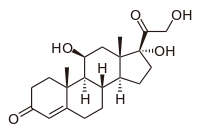3-Beta-Hydroxysteroid Dehydrogenase Deficiency

3-beta (β)-hydroxysteroid dehydrogenase (HSD) deficiency is an inherited disorder that affects hormone-producing glands including the gonads (ovaries in females and testes in males) and the adrenal glands. The gonads direct sexual development before birth and during puberty. The adrenal glands, which are located on top of the kidneys, regulate the production of certain hormones and control salt levels in the body. People with 3β-HSD deficiency lack many of the hormones that are made in these glands. 3β-HSD deficiency is one of a group of disorders known as congenital adrenal hyperplasias that impair hormone production and disrupt sexual development and maturation.
There are three types of 3β-HSD deficiency: the salt-wasting, non-salt-wasting, and non-classic types. In the salt-wasting type, hormone production is extremely low. Individuals with this type lose large amounts of sodium in their urine, which can be life-threatening. Individuals affected with the salt-wasting type are usually diagnosed soon after birth due to complications related to a lack of salt reabsorption, including dehydration, poor feeding, and vomiting. People with the non-salt-wasting type of 3β-HSD deficiency produce enough hormone to allow sodium reabsorption in the kidneys. Individuals with the non-classic type have the mildest symptoms and do not experience salt wasting.
In males with any type of 3β-HSD deficiency, problems with male sex hormones lead to abnormalities of the external genitalia. These abnormalities range from having the opening of the urethra on the underside of the penis (hypospadias) to having external genitalia that do not look clearly male or female (ambiguous genitalia). The severity of the genital abnormality does not consistently depend on the type of the condition. Because of the hormone dysfunction in the testes, males with 3β-HSD deficiency are frequently unable to have biological children (infertile).
Females with 3β-HSD deficiency may have slight abnormalities of the external genitalia at birth. Females affected with the non-salt-wasting or non-classic types are typically not diagnosed until mid-childhood or puberty, when they may experience irregular menstruation, premature pubic hair growth, and excessive body hair growth (hirsutism). Females with 3β-HSD deficiency have difficulty conceiving a child (impaired fertility).
Frequency
The exact prevalence of 3β-HSD deficiency is unknown. At least 60 affected individuals have been reported.
Causes
Mutations in the HSD3B2 gene cause 3β-HSD deficiency. The HSD3B2 gene provides instructions for making the 3β-HSD enzyme. This enzyme is found in the gonads and adrenal glands. The 3β-HSD enzyme is involved in the production of many hormones, including cortisol, aldosterone, androgens, and estrogen. Cortisol has numerous functions such as maintaining energy and blood sugar levels, protecting the body from stress, and suppressing inflammation. Aldosterone is sometimes called the salt-retaining hormone because it regulates the amount of salt retained by the kidney. The retention of salt affects fluid levels and blood pressure. Androgens and estrogen are essential for normal sexual development and reproduction.
3β-HSD deficiency is caused by a deficiency (shortage) of the 3β-HSD enzyme. The amount of functional 3β-HSD enzyme determines whether a person will have the salt-wasting or non-salt-wasting type of the disorder. Individuals with the salt-wasting type have HSD3B2 gene mutations that result in the production of very little or no enzyme. People with the non-salt-wasting type of this condition have HSD3B2 gene mutations that allow the production of some functional enzyme, although in reduced amounts.
Learn more about the gene associated with 3-beta-hydroxysteroid dehydrogenase deficiency
Inheritance Pattern
This condition is inherited in an autosomal recessive pattern, which means both copies of the gene in each cell have mutations. The parents of an individual with an autosomal recessive condition each carry one copy of the mutated gene, but they typically do not show signs and symptoms of the condition.